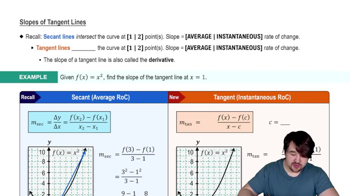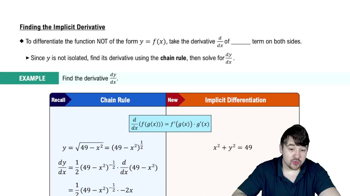Table of contents
- 0. Functions7h 52m
- Introduction to Functions16m
- Piecewise Functions10m
- Properties of Functions9m
- Common Functions1h 8m
- Transformations5m
- Combining Functions27m
- Exponent rules32m
- Exponential Functions28m
- Logarithmic Functions24m
- Properties of Logarithms34m
- Exponential & Logarithmic Equations35m
- Introduction to Trigonometric Functions38m
- Graphs of Trigonometric Functions44m
- Trigonometric Identities47m
- Inverse Trigonometric Functions48m
- 1. Limits and Continuity2h 2m
- 2. Intro to Derivatives1h 33m
- 3. Techniques of Differentiation3h 18m
- 4. Applications of Derivatives2h 38m
- 5. Graphical Applications of Derivatives6h 2m
- 6. Derivatives of Inverse, Exponential, & Logarithmic Functions2h 37m
- 7. Antiderivatives & Indefinite Integrals1h 26m
- 8. Definite Integrals4h 44m
- 9. Graphical Applications of Integrals2h 27m
- 10. Physics Applications of Integrals 2h 22m
4. Applications of Derivatives
Implicit Differentiation
Problem 3.8.74
Textbook Question
73–78. {Use of Tech} Normal lines A normal line at a point P on a curve passes through P and is perpendicular to the line tangent to the curve at P (see figure). Use the following equations and graphs to determine an equation of the normal line at the given point. Illustrate your work by graphing the curve with the normal line. <IMAGE>
Exercise 46
 Verified step by step guidance
Verified step by step guidance1
Identify the given curve equation and the specific point P where you need to find the normal line. Let's denote the curve as y = f(x) and the point as P(a, b).
Calculate the derivative of the curve, f'(x), to find the slope of the tangent line at point P. This involves differentiating the function y = f(x) with respect to x.
Evaluate the derivative at the point P to find the slope of the tangent line. This is done by substituting x = a into f'(x) to get the slope m_tangent = f'(a).
Determine the slope of the normal line. Since the normal line is perpendicular to the tangent line, its slope m_normal is the negative reciprocal of the tangent slope: m_normal = -1/m_tangent.
Use the point-slope form of a line to write the equation of the normal line. The point-slope form is y - b = m_normal(x - a), where (a, b) is the point P and m_normal is the slope of the normal line.
 Verified video answer for a similar problem:
Verified video answer for a similar problem:This video solution was recommended by our tutors as helpful for the problem above
Video duration:
5mPlay a video:
Was this helpful?
Key Concepts
Here are the essential concepts you must grasp in order to answer the question correctly.
Tangent Line
A tangent line to a curve at a given point is a straight line that touches the curve at that point without crossing it. The slope of the tangent line represents the instantaneous rate of change of the function at that point, which is determined by the derivative of the function. Understanding tangent lines is crucial for finding normal lines, as the normal line is defined in relation to the tangent.
Recommended video:

Slopes of Tangent Lines
Normal Line
A normal line at a point on a curve is a line that is perpendicular to the tangent line at that same point. To find the equation of the normal line, one must first determine the slope of the tangent line and then use the negative reciprocal of that slope. This concept is essential for solving problems involving normal lines, as it directly relates to the geometry of the curve.
Recommended video:

Slopes of Tangent Lines
Slope and Derivatives
The slope of a line is a measure of its steepness, calculated as the change in the y-coordinate divided by the change in the x-coordinate. In calculus, the derivative of a function at a point gives the slope of the tangent line to the curve at that point. This relationship is fundamental for determining both the tangent and normal lines, as it provides the necessary slopes to construct their equations.
Recommended video:

Slopes of Tangent Lines

 5:14m
5:14mWatch next
Master Finding The Implicit Derivative with a bite sized video explanation from Nick
Start learningRelated Videos
Related Practice



